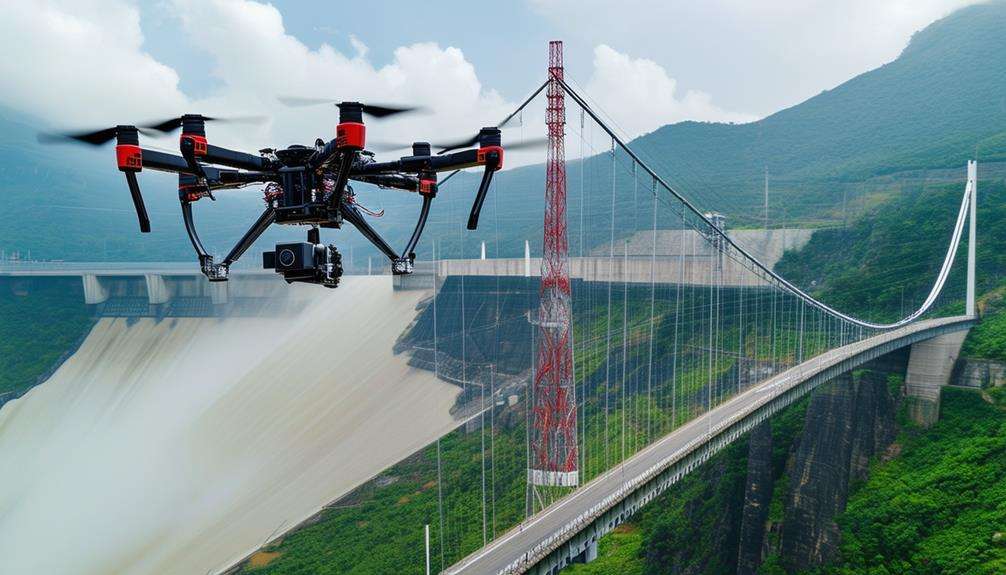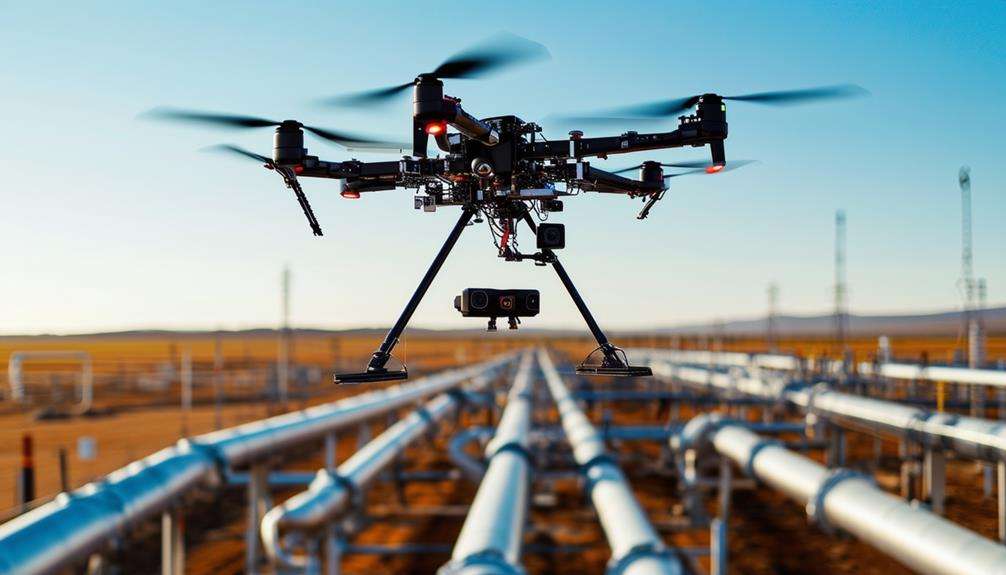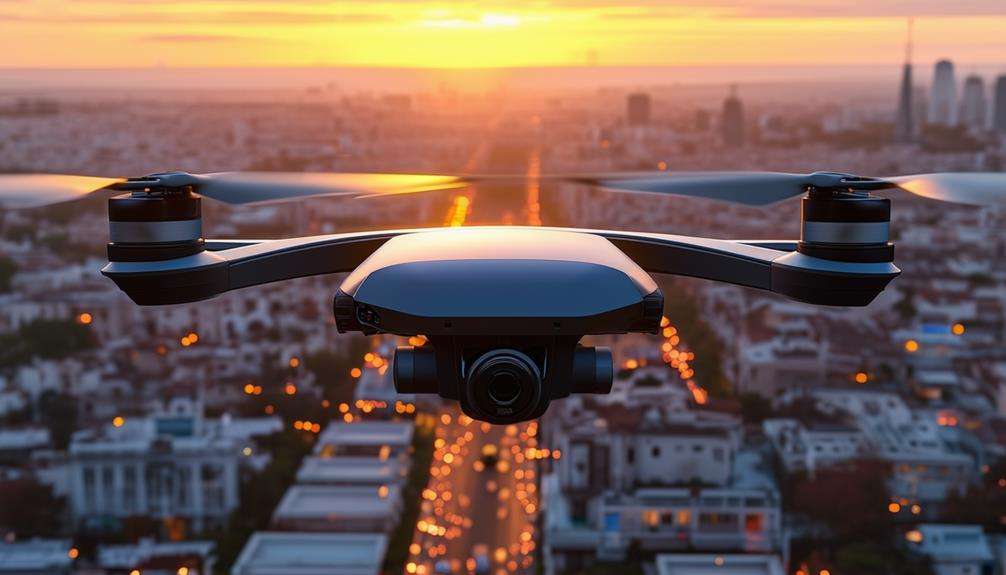The Challenges and Opportunities of Urban Drone Delivery
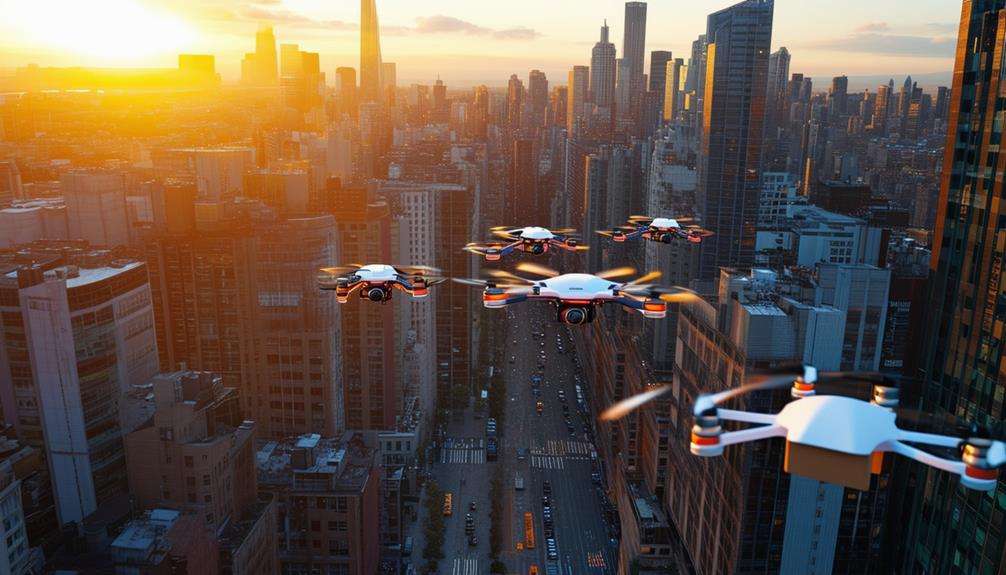
Urban drone delivery is generating significant interest, but have you considered the intricate challenges and promising opportunities it presents? Navigating crowded cityscapes, overcoming physical barriers, and complying with stringent regulations are just the beginning. However, advancements in navigation systems and obstacle avoidance technologies could transform these challenges into opportunities.
Envision a future where seamless deliveries enhance logistics and convenience. Balancing innovation with safety and public trust is complex, but that's precisely what makes this field so compelling.
Navigating Urban Landscapes
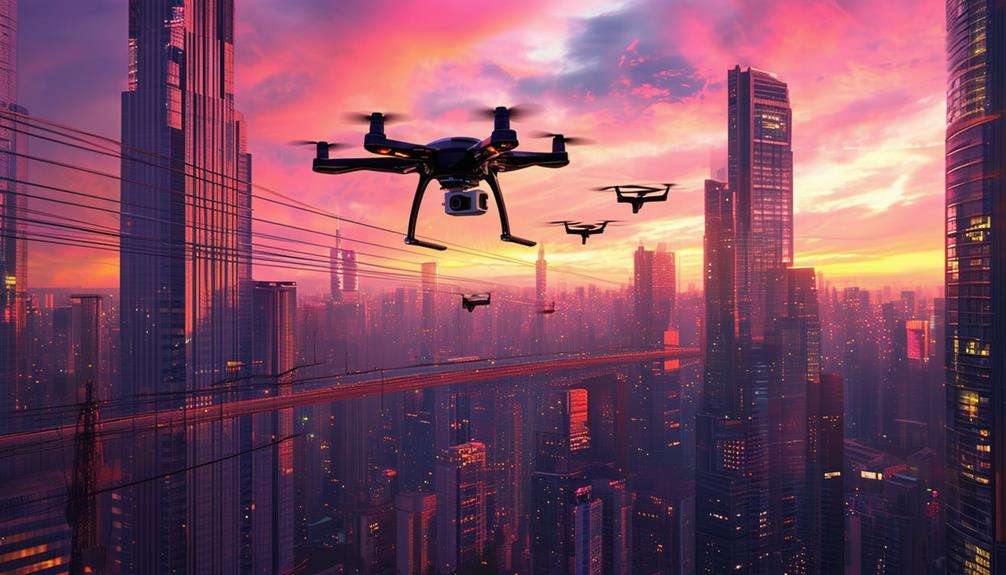
Operating drone delivery services in urban areas involves overcoming numerous obstacles such as buildings, traffic, and restricted airspace. Navigating these complex environments requires advanced technologies and highly efficient operations.
Drones need sophisticated navigation systems like lidar, radar, and GPS to navigate safely and effectively. These systems help drones map out optimal routes, avoiding congested areas and adhering to regulatory guidelines.
Urban operations are particularly challenging due to the dense population and numerous physical barriers. Efficient route planning is crucial to ensure timely deliveries and minimize risks. Regulatory challenges also come into play, as drones must comply with local and national guidelines to operate safely in densely populated areas. This includes understanding and adhering to airspace restrictions and other specific urban regulations.
Overcoming these urban challenges presents significant potential for drone delivery. It can revolutionize last-mile logistics, making deliveries faster and more efficient. By leveraging advanced navigation systems and strategic planning, drone operations in cities can be maximized. This not only improves delivery services but also contributes to a more efficient and innovative logistics landscape.
Obstacle Avoidance
Effective obstacle avoidance is essential for the safety and efficiency of urban drone delivery operations. As drones navigate densely populated areas filled with buildings, trees, and other structures, they rely on advanced obstacle avoidance systems to prevent collisions. These systems typically employ sensors like ultrasonic sensors and infrared cameras, which detect obstacles in real-time, allowing drones to adjust their flight paths accordingly.
GPS technology also plays a crucial role in obstacle avoidance by providing accurate location data. This data enables drones to autonomously navigate complex urban environments, ensuring they remain on course. With precise GPS coordinates, drones can make real-time route adjustments, enhancing their ability to avoid collisions.
Autonomous navigation technology is another critical component. It enables drones to process sensor data quickly and make split-second decisions to avoid obstacles. This capability is particularly important in urban delivery scenarios, where unexpected obstacles can suddenly appear.
Incorporating effective obstacle avoidance systems is vital for the successful integration of drones into urban airspace. By leveraging advanced technologies and accurate location data, drones can safely and efficiently complete delivery tasks, making urban delivery a viable and reliable option.
Ensuring Safety
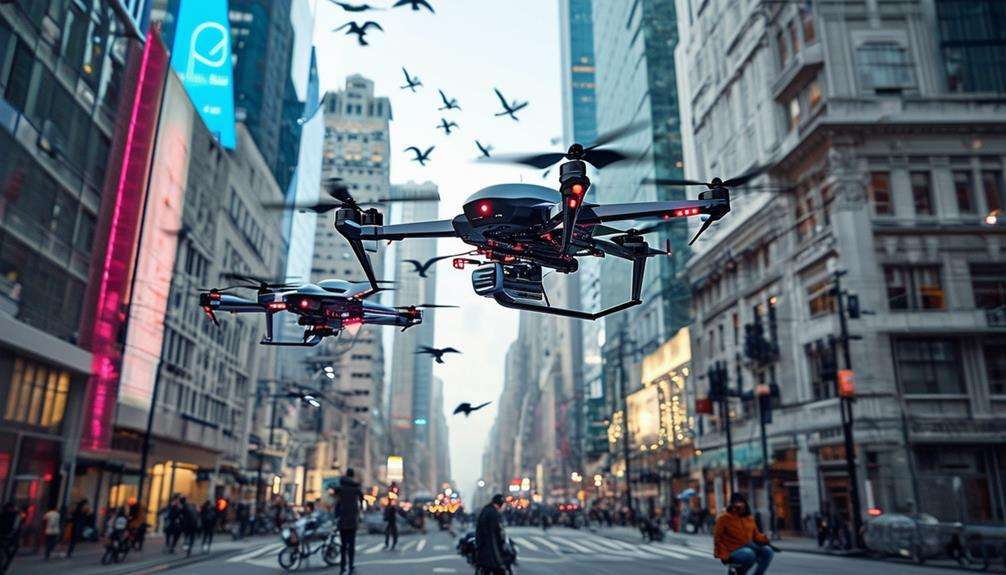
Ensuring safety in urban drone delivery requires more than just advanced obstacle avoidance systems. Robust collision prevention technologies like radar and lidar are essential for detecting and avoiding obstacles. However, safe operations in complex urban airspace involve several critical considerations.
Key Safety Considerations for Urban Drone Delivery:
- Collision Prevention Technologies: Utilize radar and lidar systems to enhance obstacle detection and avoidance.
- Line of Sight: Maintain a clear line of sight with your drone to comply with regulations, which can be challenging in densely populated areas.
- Regulatory Compliance: Follow all applicable rules and guidelines to avoid legal complications.
- Operational Safety Measures: Adhere to prescribed altitude and speed limits to minimize the risk of accidents.
- Restricted Areas: Be vigilant about no-fly zones and sensitive regions to ensure safe operations.
Regulatory Concerns
Navigating the regulatory landscape for urban drone delivery can be complex, but understanding the key rules and guidelines is crucial for safe and compliant operations. Mastering the regulatory frameworks requires awareness of airspace management, flight restrictions, and strict adherence to safety regulations.
Urban environments introduce unique regulatory challenges, such as line-of-sight requirements, no-fly zones, and altitude limitations. These regulations are designed to ensure that drone operations don't compromise public safety or privacy.
Clear guidelines from regulatory bodies, such as the FAA, are essential for addressing critical issues like safety, security, and privacy—concerns that are particularly significant in densely populated areas. Without these guidelines, maintaining public trust and acceptance of drone technology in urban settings would be difficult.
Compliance extends beyond merely following rules; it also involves contributing to a safer airspace. Effective airspace management is key to preventing accidents and ensuring harmonious coexistence between drones and manned aircraft.
Collaboration among stakeholders, regulators, and industry participants is vital. By working together, stakeholders can better navigate these complex regulatory frameworks and create a safer, more efficient urban drone delivery system. Successfully understanding and addressing these regulatory challenges forms the cornerstone of successful urban drone operations.
Advanced Navigation Systems
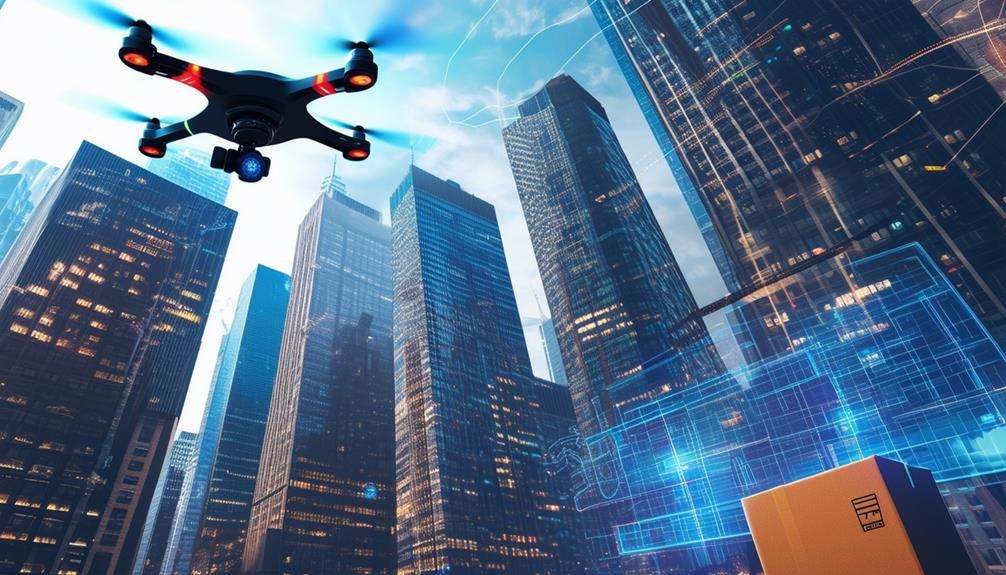
In the realm of urban drone delivery, advanced navigation systems are crucial for ensuring precision and safety. These systems enable drones to navigate complex urban environments filled with obstacles and dynamic elements efficiently. GPS technology provides drones with the ability to follow autonomous routes with remarkable accuracy, enhancing the reliability and efficiency of urban delivery operations.
Drones are equipped with a variety of sensors and cameras to improve their navigational capabilities. Ultrasonic sensors assist in obstacle detection, preventing collisions by identifying potential hazards in the drone's path. Infrared cameras are also utilized, enabling drones to perform tasks like thermal imaging, which can be essential in specific delivery scenarios.
Key components that make advanced navigation systems indispensable in urban drone delivery include:
- GPS Technology: Provides precise location tracking and enables autonomous route following.
- Ultrasonic Sensors: Detect obstacles to prevent collisions.
- Infrared Cameras: Facilitate thermal imaging and other specialized tasks.
- Autonomous Routes: Pre-planned paths that drones follow to optimize efficiency.
- Real-Time Data: Continuous updates from sensors and cameras for adaptive navigation.
These elements collectively ensure that drones can operate safely and efficiently in urban environments, making advanced navigation systems an essential part of modern drone delivery services.
Public Trust
In the context of urban drone delivery, public trust is paramount, especially concerning privacy and security. People worry about drones encroaching on their personal space and the potential misuse of collected data. Adhering to regulations and ensuring transparent communication are essential steps to mitigate these concerns and build public confidence.
Privacy and Security Concerns
Many worry that urban drone delivery could invade their privacy and compromise security. With drones operating over neighborhoods, addressing privacy and surveillance concerns is crucial. Drones equipped with cameras and GPS technology can potentially capture more than just delivery routes, leading to unauthorized access to personal spaces and data.
To build public trust and ensure widespread acceptance, companies must tackle these security risks directly. Protecting data and package integrity is essential. Implementing robust encryption protocols and secure communication channels can help safeguard sensitive information and prevent unauthorized access to drone systems.
Key concerns and solutions include:
- Privacy Concerns: Drones could inadvertently record private activities within homes or yards.
- Surveillance Issues: Continuous drone flights might feel like constant surveillance.
- Security Risks: Drones may be hacked, leading to unauthorized access or alteration of delivery routes.
- Unauthorized Access: Sensitive customer data could be compromised if not properly secured.
- Public Trust: Transparency in data usage and protection can foster trust and confidence in drone delivery systems.
Regulatory Compliance Issues
Building public trust in urban drone delivery requires strict adherence to regulatory compliance and transparent communication. To ensure drones operate safely and securely within urban airspace, they must follow established regulatory frameworks addressing critical concerns such as safety, privacy, and airspace management. Compliance with these regulations fosters a sense of security and reliability among the public.
Transparent communication is essential. When people understand how regulatory compliance is being met, their trust in drone technology increases. Openly share information on how drones are monitored and controlled to prevent accidents and how data privacy is maintained. This transparency reassures the public that their safety and privacy are prioritized.
Additionally, ethical practices in drone delivery are crucial. Demonstrate a commitment to using drones responsibly, ensuring they don't infringe on people's privacy or disrupt their daily lives. By following ethical guidelines consistently and communicating these efforts clearly, a positive perception of drone technology in urban environments is built. Ultimately, strict regulatory compliance, transparent communication, and ethical practices are vital to gaining and maintaining public trust in urban drone delivery.
Economic Growth
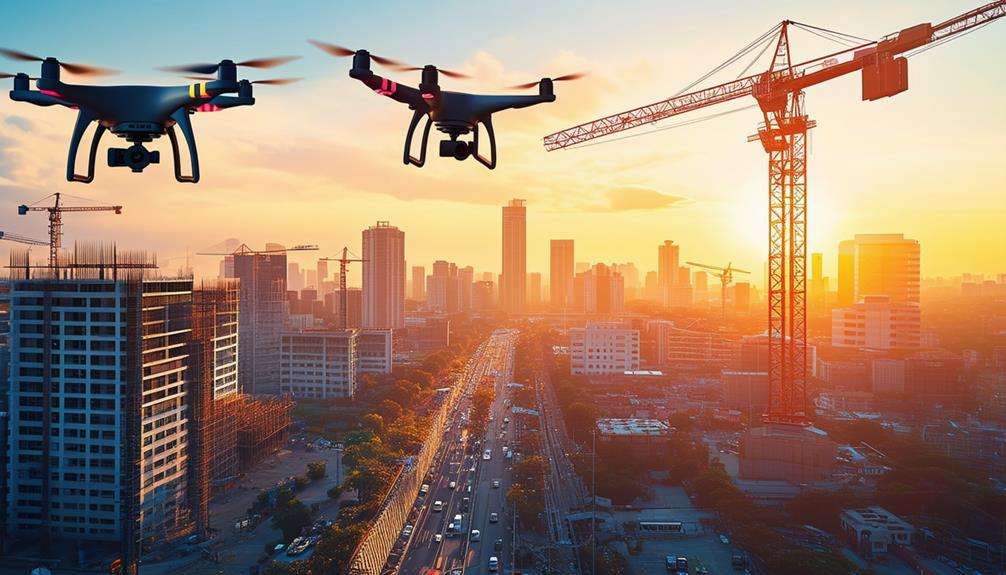
Urban drone delivery presents a significant opportunity to boost local businesses by reducing delivery costs and optimizing logistics. This innovation also has the potential to create new job opportunities within the industry.
Boosting Local Businesses
Embracing urban drone delivery can significantly enhance local businesses by offering faster and more efficient services. This technology can lead to a notable increase in customer satisfaction and loyalty due to rapid and reliable order fulfillment. As local businesses integrate drone technology, they unlock numerous economic growth opportunities.
Urban drone delivery can streamline inventory management, making supply chains more responsive and less prone to delays. This efficiency helps maintain optimal stock levels and reduces the risk of running out of popular items. Additionally, adopting drones can create jobs, as new roles emerge to support this advanced delivery method.
Here are some benefits you can expect:
- Quicker Deliveries: Meet customer demands with same-day or hour-specific deliveries.
- Improved Inventory Management: Ensure your supply chain operates smoothly and efficiently.
- Increased Revenue Generation: Attract more customers with the promise of speedy deliveries.
- Competitive Edge: Differentiate from competitors with cutting-edge delivery options.
- Job Creation: New roles in drone maintenance, operation, and logistics.
Reducing Delivery Costs
As local businesses benefit from faster deliveries, they also gain from the substantial cost reductions that urban drone delivery provides. Transitioning from traditional delivery methods to drones can cut delivery costs by up to 80%. This significant reduction helps minimize operational expenses related to labor, fuel, and vehicle maintenance. Unlike conventional delivery vehicles, drones bypass traffic in congested urban areas, ensuring quicker and more efficient last-mile delivery.
Implementing urban drone delivery does more than just cut costs—it fosters economic growth opportunities. With lower operational expenses, businesses can redirect resources to other growth avenues, enhancing overall profitability. The efficiency gained from optimized routes and reduced transportation costs enables businesses to handle more deliveries without increasing expenses, boosting productivity and competitiveness.
Furthermore, the cost-effective nature of drone delivery helps maintain a steady revenue stream while alleviating the financial burden of traditional delivery methods. Consequently, businesses can experience increased revenue and efficiency, contributing positively to the local economy. Embracing urban drone delivery not only reduces delivery costs but also positions businesses for long-term economic growth.
Job Creation Potential
Urban drone delivery is increasingly recognized for its potential to create numerous job opportunities across various sectors. As the industry grows, the demand for skilled drone operators who can expertly navigate urban environments will rise. Maintenance technicians will also be essential to ensure these drones remain in optimal working condition. The economic impact of urban drone delivery extends beyond these roles, fostering job growth and contributing to economic development in multiple ways.
Key job opportunities in urban drone delivery include:
- Drone Operators: Skilled professionals responsible for piloting drones, ensuring timely and accurate deliveries.
- Maintenance Technicians: Experts tasked with keeping drones in excellent condition through regular checks and repairs.
- Software Developers: Innovators who design the algorithms and systems that enable efficient drone operations.
- Logistics Coordinators: Planners who manage the complex scheduling and routing of drone deliveries.
- Regulatory Compliance Specialists: Professionals who ensure that drone operations comply with all legal and safety standards.
Emerging training programs and certifications are addressing the need for these skilled professionals, leading to the creation of thousands of new jobs. Urban drone delivery isn't just a technological advancement; it's a significant catalyst for economic growth and job creation.
Environmental Impact
Urban drone delivery offers a crucial alternative to traditional delivery methods, significantly reducing carbon emissions and minimizing the use of fossil fuel-dependent vehicles. This shift not only supports environmental sustainability but also enhances air quality in congested urban areas. As electric drones are emission-free, they're instrumental in advancing green initiatives. Businesses adopting drone delivery align with these initiatives and contribute to a more sustainable logistics ecosystem.
Drone delivery emerges as a pivotal solution when considering environmental impact. Traditional delivery vehicles, reliant on fossil fuels, contribute to pollution and traffic congestion. In contrast, drones bypass road congestion, making deliveries faster and cleaner. This reduction in vehicle emissions directly improves air quality, benefiting the urban population.
Conclusion
Urban drone delivery presents both challenges and opportunities. By adopting advanced navigation systems, prioritizing obstacle avoidance, and adhering to strict regulatory standards, we can revolutionize urban logistics.
Building public trust and considering economic and environmental impacts are crucial. Through collaborative efforts and innovative solutions, urban drone delivery can become safer, more efficient, and transformative for city living.

